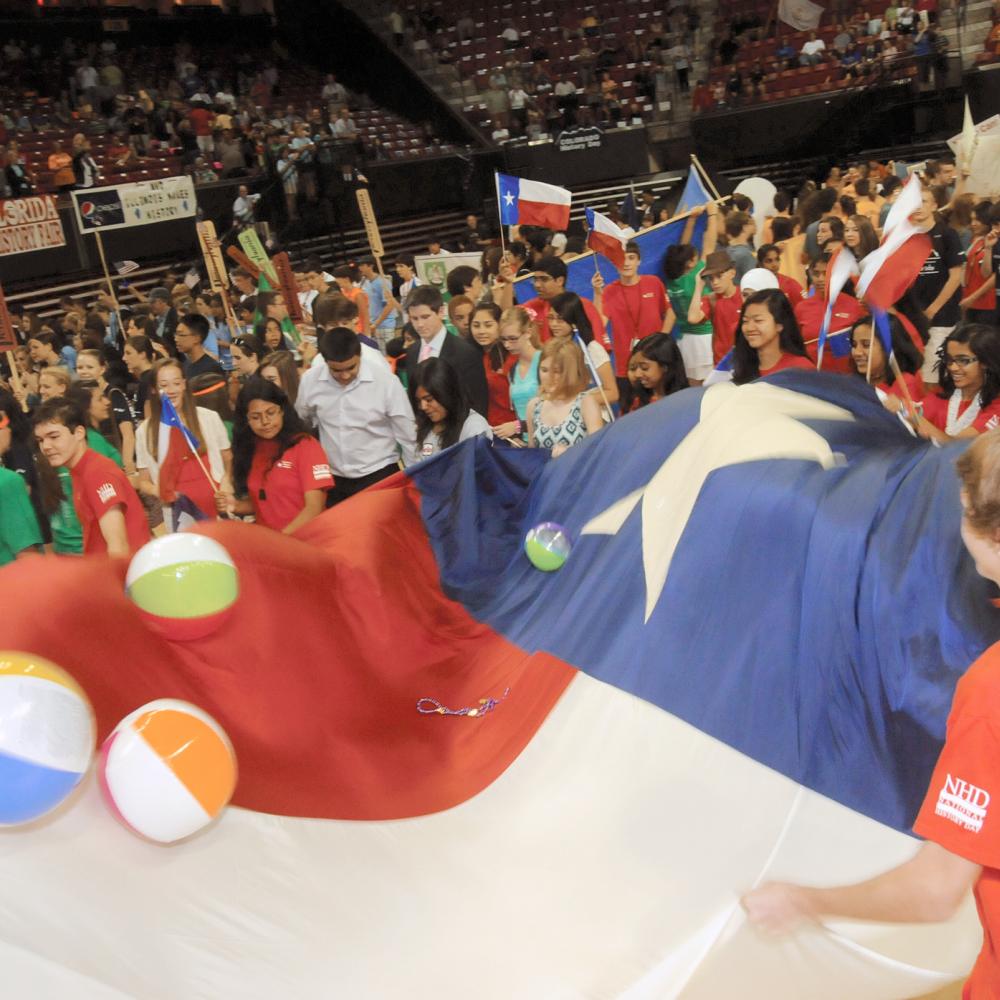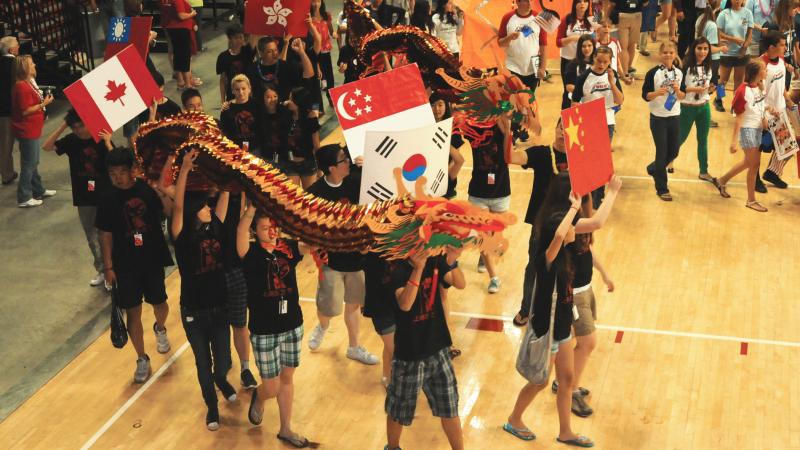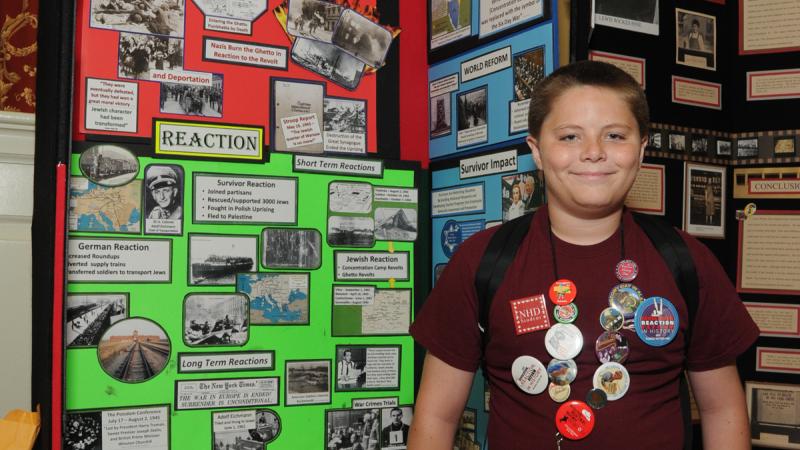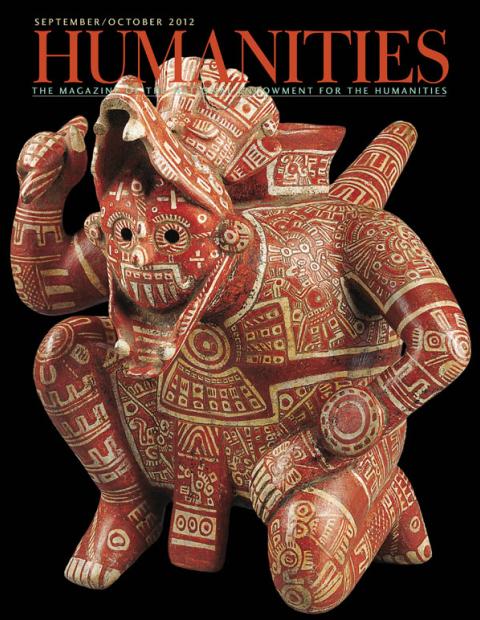The basketball court at the University of Maryland’s Comcast Center teemed with middle and high school students here for the closing ceremony of the National History Day Contest. Music blared, flags waved, and inflatable orcas and dairy cows cavorted through the air during the parade of states, a prelude to the awarding of medals, prizes, and a four-year scholarship.
A mix of Mardi Gras, Chinese New Year (complete with dragon), and halftime hoopla, the parade, which takes place every June, was more an organized swarm than a march. In harvest yellow T-shirts, the New Mexico delegation dared to carry a “Fear the Chile” banner in Terrapin territory. Near midcourt, the Lone Star State team held the four sides of a huge Texas flag, waving it and sending beach balls skyward. The Massachusetts team moved clockwise against the traffic. In the red-clad Connecticut contingent, a student carried a sign saying “Connecticut—Still Revolutionary,” perhaps in homage to the state’s history, possibly in honor of the 2012 History Day theme: Revolution, Reaction, Reform in History.
During the 2011–2012 school year, more than 600,000 students in the United States and abroad wrestled with the implications of revolution as they researched papers, built websites, constructed exhibits, made documentaries, or created history-based performances. Then, individually or in groups, the students put their work forward for judging at the school, regional, and state level. For the 2,800 who made it all the way to nationals, the parade is a let-loose celebration to cap a year marked by many Saturdays in the library. Over the previous three days, a cast of some 350 judges— among them teachers, lawyers, journalists, and park rangers—have scrutinized their work, questioning the students about projects that have been months in the making. For parents, teachers, judges, and well-wishers in the stands—some of whom had competed in History Day years ago and continue to plan their schedules around the annual event—it is a confirmation that a history geek is a great thing to be.
My introduction to National History Day begins earlier in the week at a training session where Cathy Gorn, NHD’s executive director, exhorts the experienced and newbie judges: “This is the students’ opportunity to be the expert. Even if you wrote a book about the subject, let them speak.”
Gorn reminds them that 60 percent of the score is based on the quality of the history: accuracy, analysis, and context. Clarity of presentation gets 20 percent, and tying the project to the theme is worth 20 percent. In their review, the judges must look at the students’ annotated bibliographies and the process papers that describe how they went about their work, and the projects must adhere to the rules for their categories. Interviews with students should be brief, and they should not be the factor that tips them into finals.
Gorn tells them that when the closing ceremony is over, many students will rush to get the judges’ evaluations. They are like “gold” to the students, she says. Make constructive comments.
“Your job is not to be judges, but to be teachers,” she says. “Give them the power to do better.”
Gorn has been pushing history for thirty years and knows how to get a laugh out of her audience. “NO CUTE POINTS! Your hearts are going to melt, but don’t give cute points.”
Half an hour later, I realize that it takes more than a little resolve on the part of judges to follow this directive. The hallway is full of middle school students primping and powdering for junior group performances. One girl, dressed as Elizabeth Cady Stanton, brushes aside the woman arranging her curls, saying Stanton’s hair was a mess and “she looked like a pigeon.”
In a windowless room notable for its complete lack of character, Emma Nelson and Cami Dougal from Mountain View Middle School in Idaho set up for their performance of Beaten, Battered, and Bruised: Rescuing Society from the Wrath of the Devil’s Bottle. After handing over their documentation to the trio of judges whose backs face the audience, the girls briskly go about the business of setting up the sheeted frame that screens them during the costume changes that will occur about every two-and-a-half minutes, a dizzying pace in a ten-minute piece.
Hair pulled back primly, long skirts swaying, their opening scene has the characters Mary (Dougal) and Anna (Nelson) discussing James, Mary’s drunken husband, and Anna’s support of temperance. In subsequent scenes, James confronts Mary; then James and the bartender (also played by the girls) discuss what they see as the unreasonable behavior of women. The barkeep (Dougal) laments that temperance supporters had dumped ten dollars of liquor. “It’s scaring off the gents. What is a barkeep to do?” In the closing scene, the women discuss the passage of the Eighteenth Amendment.
“We [each] wanted to be a boy and a girl, and I couldn’t play my own husband,” Dougal replies after the judges ask them about their work process, scripting, and casting.
Next up are Californians Bianca Burgos and Felicia Zhornitsky in Revolutionary Women in Medicine. As the judges look over their paperwork, Zhornitsky watches anxiously and Burgos shifts from foot to foot in front of their set, a doctor’s office with pictures on the walls of Dr. Elizabeth Blackwell, the first woman to obtain a medical degree in the United States, and hospital reformer Florence Nightingale.
“Whenever you are ready, you may begin,” says the middle judge.
In their opening scene, Zhornitsky plays a student interviewing a woman doctor for a History Day project. The action quickly slips back to the nineteenth century of Blackwell and Nightingale. In their dialog, the girls use “Failure never seemed possible,” a quote from Blackwell when she was accepted by Geneva Medical College in 1847. The quote is a harbinger of what is to come. In one scene, Burgos, writing with a plume, speaks eloquently and with splendid diction, using Nightingale’s own words to describe the dreadful state of hospitals and the need for change. (Afterward, Burgos confesses that she was nervous.)
Bringing the challenges of women in medicine forward, the girls cover Virginia Apgar, the doctor who developed the scale to evaluate newborns; Antonia Novello, surgeon general under George H. W. Bush; Nancy Andrews, first female dean of medicine at Duke University; and Nobelist Carol Greider.
At the end, a judge asks, “What did you learn?” Zhornitsky replies, “We can become what we dream to be.”
As I watch them, I am struck by the fact that these middle school girls took it upon themselves to request interviews with Novello, Greider, and Andrews. “It’s not every day when you get the chance to talk to remarkable women in the medical field,” they wrote in their process paper, indeed an understatement.
Over the next two days, I see to what lengths History Day competitors go to understand their subjects. Blacksburg middle schoolers Anna Britt, Aislinn Leedy, and Sophia Thompson traveled from Virginia to New York to conduct interviews for their junior group documentary Triangle: The Fire that Reformed Safety Legislation. There they met with former State Senator Seraphin Maltese, whose great-grandmother and two great aunts died in the Triangle Shirtwaist Factory fire. On screen, the students used clips from their interview with author and labor lawyer Joel Sosinsky. For their exhibit “Schwartze Vogelmenshen,” Jordan Hughes and Taylor Knight of Oklahoma interviewed Edward Woodward, a Tuskegee airman.
Seventh graders Sydney Polson and Sadie Thatch were thrilled that chefs Emeril Lagasse and Jacques Pépin and Judith Jones, Julia Child’s editor at Alfred Knopf, responded to requests for e-mail interviews for Our Lady of the Ladle, their documentary about Julia Child’s revolutionary impact on American cooking. Because of Julia, Emeril Lagasse “is not afraid to have fun,” Polson says.
They pored over cookbooks and watched DVDs on French cooking and the recent film Julie & Julia—and then they did what Julia Child would have wanted them to do. They cooked. They made beef bourguignon and crème brûlée. They followed Child’s many-paged omelette treatise in Mastering the Art of French Cooking. “It felt like she was there” to help, says Polson, who encourages me to try Julia-style cooking. Clearly, they had fun, and Polson is even considering becoming a chef.
When I ask what they got out of doing History Day, Thatch thinks for a moment. “Life skills that you don’t learn till you are older.”
From the Judges
The breadth of topics at the competition is stunning. Among them are Meiji Japan, social media in the Egyptian revolution, Michael Collins and the Easter Rising, the Scopes trial, the Stonewall riots, the Copernican revolution, Polish Solidarity, and the 1966 basketball game between Texas Western and Kentucky. Curiosity drove the topic choice for some students. Others were influenced by family history—a fifth great-grandfather who died for the Union, a grandmother who grew up under segregation in Missouri, a grandfather who served in Vietnam.
All students strive for something that will stand out, and by the time they get to College Park, particularly in the last round, the work of judges gets harder because these projects are the cream of the crop, says Wendy Toole, a regional coordinator for History Day in Pennsylvania and a junior performance judge this year.
Projects that go forward tend to be creative and tightly focused. Projects are more likely to suffer when they are too broad, which happens more at the junior level, says Toole.
Students are allowed only five hundred of their own words for analysis and interpretation; exhibits have a size limit, thus preventing any student from gaining an unfair advantage by squeezing in extra material. To get into the final round for exhibits, a project “has to be like a museum exhibit in that it tells a story and stands on its own,” says Gorn.
There is no special secret way to get to nationals, according to Sharon Wlodarczyk, the History Day adviser for Pomperaug High School in Connecticut. Seventh grade is when they figure out how to do a project, she says, and they get better with practice.
“It helps if a topic starts local but has a national importance,” says Wlodarczyk, who judged in Connecticut this year.
The best projects make every word count, and they are cleverly put together, says Alex Wellerstein, associate historian at the American Institute of Physics and a judge of websites. “All of the ones we liked were unusual.”
Two standouts—partly because the judges did not know much about the topics—are “Ben Reitman: The Hobo Doctor Who Gave Societal Misfits a Purpose,” which covers the life of the anarchist doctor who was the lover of Emma Goldman, and “The Orange Alternative: An Illegal Meeting of the Dwarves,” a cryptically named project about a group of protesters who used absurd graffiti and street happenings to create what Wellerstein called “an unusual political space” in communist-era Poland.
To watch judges in action, I trail a team captained by Richard Horowicz, a teacher at the Talmudical Academy of Baltimore, who has judged since the 1980s. Joining him are Denise Hoke, who teaches social studies and world cultures to sixth graders in Baltimore County, and Rebecca Heinen, a former History Day competitor who traveled from Michigan to judge. Their task is to evaluate thirteen projects and interview students in Group B in the first round of competition for senior group exhibits. As they go about their work, six additional judging teams for this category are doing the same thing across the Grand Ballroom of the Stamp Student Union.
To keep things fair, Group B includes no students from the judges’ home states, and the judges are not given the names of the students’ schools or their home states. They have only the names of the students and their topics, which range from Frank Lloyd Wright to flappers, from the Boxer Rebellion to the Black Panthers. Unafraid to take on complex issues, one group tackled the failure of Indian boarding schools and another the mixed results of China’s one-child policy. The impact of science in modern life showed up in projects about Norman Borlaug, a plant breeder who led the Green Revolution, and on HeLa cells, which have transformed medical research. “We’re seeing more science-themed projects because of the emphasis on STEM (Science, Technology, Engineering and Mathematics),” says Hoke.
As they move through the exhibits before the students arrive, the judges comment.
“Am I being too critical in saying there should be more information about other nations?”
“Maybe. They are limited for space.”
“Think we ought to measure this one?”
“There’s no ‘why’ here.”
“That left panel looks like it was added later.”
“They did their research quotes, but where are their own words?”
“I like that they divide the cultural, social, and scientific impacts.”
“They are using old information.”
“The analysis is in here somewhere.”
In this preliminary review, the judges consider what questions to pose to the students when they enter. As Horowicz explains while walking through the exhibit hall, the interviews can change what judges think about a project, and show the effort that went into it. Sometimes someone “really knows his stuff,” yet that information doesn’t make it into the exhibit.
“A judge needs to gauge his assessments in light of the student’s level,” says Horowicz, and then use the evaluation forms to offer both praise and suggestions for improvement. His best advice for students: Write a thesis and a conclusion and make them easy to see.
At the beginning of each group interview, there are pleasant introductions and polite handshakes all around. In understated ways, the judges ask open-ended questions to suss out what outside help students received and to determine how they divided the work. Always, they are looking for the “so what” factor. “I want to know what a kid knows,” says Hoke.
The judges stay positive with comments like “nice tribute” or “good use of quotes,” but they do not tip their hands about their preferences.
Group B is a talented, questioning, persevering lot. Owen Bailey, Kolton Ponté, and Caleb Smith from Springdale, Arkansas, go back and forth confidently describing the roles of all the Chinese and foreign players in the Boxer Rebellion. But they are really chuffed with themselves when asked about the construction of their exhibit, which is topped with a distinctive roof made of bamboo shading and red finials held together with glue and duct tape. For inspiration, “we pulled up a picture of a Chinese teahouse,” says Ponté.
Iowans Jeanne Edson and Katie Karels are equally creative, using corrugated roofing, barn boards, and baling twine to artfully explain Borlaug’s role in reducing hunger by creating better food crops.
Tori Stanek and Miranda Hosking from Wyoming looked at Indian boarding schools as an example of a failed reform. They rhetorically ask why such things are not covered in school. “It’s such an ugly part of our history,” says Hosking.
The face-to-face interview, which is required of participants in every category, “really helps build confidence at a young age,” says Heinen, who herself competed three times in the 1990s.
At the Museum
The evening before the closing ceremony, I saw my last exhibit—this time at the National Museum of American History in Washington, D.C. “Radium Girls: Tragedy Leading to Industrial Reform,” by Timothy Cohn from Pomperaug High School in Southbury, Connecticut, was one of a sampling of History Day projects from the states and territories chosen to be displayed at the museum for the day.
The project was inspired by Mary “Mae” Keane, Cohn’s 105-year-old great aunt, who had been a Radium Girl in Waterbury, Connecticut. “She lives with us and I listened to her stories growing up,” Cohn tells me.
In the early twentieth century, Radium Girls worked in factories painting watch faces with a radioactive mixture that took such significant tolls on their health that the National Consumers League took on their cause. To understand the Radium Girls’ illnesses, particularly jaw necrosis, Cohn studied a 1925 report from the Journal of the American Medical Association and the letters of the Harvard team that investigated the watch factories, and he read about worker compensation and the court cases against the companies that looked to blame something other than radium for the women’s illnesses. Quotes from some of these primary-source materials were incorporated into the exhibit. In his thesis statement, Cohn argued that “the industrial tragedy, caused by the use of radium-laced paint, paved the way for reform in occupational safety standards and workman’s compensation.” He concluded that the women who led the Consumers League were “true reformers” who “skillfully arranged and manipulated press coverage to gain the support and sympathy needed to force the issue of justice and changes to the system.”
Cohn’s project draws an audience. When Senator Richard Blumenthal of Connecticut and his wife stop by to check out his project and ask questions, Cohn’s proud parents click away.
The next morning I sit behind the Connecticut delegation and wonder how likely it is that any of the small group of students I saw in action would be running down the bleachers and galloping across the basketball court to the raised dais. For the vast majority, I don’t know what the judges thought, and while dedication, a good topic, and lively presentation skills matter, there is also an element of chance. A project that advanced out of one preliminary round may not have made it out of another round with a different mix of projects. Gorn says, “An entry is never judged on its own.”
Name after name is called for the many award categories. As Owen Bailey, Caleb Smith, and Kolton Ponté receive the state affiliate award for Arkansas, I remember that Ponté said he told his mother in the fall that he wanted to go to nationals just as his sister had done. She told him, “Make it a goal.”
When third place in the category for senior individual exhibit is called, the Connecticut delegation begins to yell and cheer, but Cohn initially does not respond, unsure that he heard correctly. “Going into the awards ceremony, I had no expectation of placing in the top three,” says Cohn. “Winning was an amazing feeling.”




